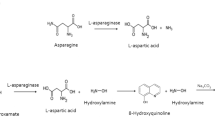Abstract
The relative efficacy and toxicity of E. coli L-asparaginase and epidoxorubicin used in remission induction therapy for childhood acute lymphoblastic leukemia (ALL) were assessed in a randomized trial conducted in Taiwan. All patients had standard-risk ALL, defined as a leukocyte count <10 × 109/l and were aged between 1 and 2 or 7 and 10 years, or a leukocyte count <50 × 109/l and were aged between 2 and 7 years, without evidence of a T cell or mature B cell immunophenotype, central nervous system leukemia or expression of two or more myeloid-associated antigens. Ninety-three patients were randomized to receive E. coli L-asparaginase at 10 000 IU/m2 thrice weekly for nine doses and 108 to receive epidoxorubicin at 20 mg/m2 weekly for two doses during remission induction with daily prednisolone, weekly vincristine and, on day 22, a dose of etoposide plus cytarabine. Patients treated with L-asparaginase had a significantly higher rate of fatal infection with or without hemorrhage than did those who received epidoxorubicin during remission induction (six of 93 vs none of 108, P = 0.009), resulting in a lower rate of complete remission in the former group (93.6 vs 99.1%, P = 0.05). In addition, patients treated with L-asparaginase had a higher frequency of hyperglycemia and hypoalbuminemia. The overall rate of event-free survival was lower in patients treated with L-asparaginase than in other patients (P = 0.06); estimated 3-year rates were 72% (95% confidence interval, 55–89%) and 87.2% (78–96%), respectively. We conclude that L-asparaginase (Leunase) given at 10 000 IU/m2 for nine doses was poorly tolerated and resulted in excessive toxicity, both through its effects as a single agent and possibly through potentiation of etoposide.
This is a preview of subscription content, access via your institution
Access options
Subscribe to this journal
Receive 12 print issues and online access
$259.00 per year
only $21.58 per issue
Buy this article
- Purchase on Springer Link
- Instant access to full article PDF
Prices may be subject to local taxes which are calculated during checkout
Similar content being viewed by others
Author information
Authors and Affiliations
Consortia
Rights and permissions
About this article
Cite this article
Liang, DC., Hung, IJ., Yang, CP. et al. Unexpected mortality from the use of E. coli L-asparaginase during remission induction therapy for childhood acute lymphoblastic leukemia: a report from the Taiwan Pediatric Oncology Group. Leukemia 13, 155–160 (1999). https://doi.org/10.1038/sj.leu.2401260
Received:
Accepted:
Published:
Issue Date:
DOI: https://doi.org/10.1038/sj.leu.2401260
Keywords
This article is cited by
-
Childhood acute lymphoblastic leukemia mercaptopurine intolerance is associated with NUDT15 variants
Pediatric Research (2021)
-
Health-related quality of life and cognitive outcomes among child and adolescent survivors of leukemia
Supportive Care in Cancer (2010)
-
Long-term results of Taiwan Pediatric Oncology Group studies 1997 and 2002 for childhood acute lymphoblastic leukemia
Leukemia (2010)
-
Induction death and treatment-related mortality in first remission of children with acute lymphoblastic leukemia: a population-based analysis of the Austrian Berlin-Frankfurt-Münster study group
Leukemia (2009)



